Rebuilding, upgrading and replacing existing forces will not be enough to make them future proof and ready to engage in rapidly changing conflicts, fought simultaneously across physical and virtual domains, in military next to traditionally civilian arenas. New future capabilities, both effective and affordable, have to be identified. This article describes six new capability development themes from Playing to Your Strenghts, a report by the The Hague Centre for Strategic Studies. The report has been used in the preparation of the Future Vision for the Royal Netherlands Army (RNLA), Security through Foresight, which describes the lines of development with a time horizon of up to 2030.
Frank Bekkers MA and dr. Tim Sweijs*
The character of conflict is changing rapidly, yet future force planning continues to be dominated by a legacy based approach. With only incremental improvements, the planned force of tomorrow very much resembles the current force of today. This holds true for the armed forces of most Western states, including those of the Netherlands. The Defence White Paper that was published in March 2018 put the modernization of the Dutch armed forces central but – it is fair to say – was more about rebuilding, upgrading and replacing the existing force than it was about reinventing the new one.[1] This poses a genuine risk to the ability of the Dutch armed forces to successfully operate in tomorrow’s conflict environment. Adding techflation to that equation yields an even stronger rationale for prudent military planners to try and identify new future capabilities which are both effective and affordable.[2]
Against this background, The Hague Centre for Strategic Studies (HCSS) was asked by the Commander of the Royal Netherlands Army (RNLA), lieutenant general Leo Beulen, to specifically identify promising new or to be renewed capabilities for the RNLA with a time horizon of 10-15 years into the future.[3] This research project resulted in the report Playing to your Strengths: A Different Perspective on Future Capabilities for the Royal Netherlands Army.[4] The report has been used in the preparation of the Future Vision for the Army Security through Foresight, launched in November 2018.[5] Both documents focus on the long lines of development that will shape the Dutch land forces with a time horizon of up to 2030, and provide input to the 2020 Memorandum of Reassessment (Herijkingsnota) that will revisit the programme outlined in the 2018 White Paper.

A long list of military-strategic challenges was used to create eleven conflict scenarios. Photo MCD, Evert-Jan Daniels
This article describes the six new capability development themes identified in our study. Our principal goal is to feed the discussion on the future force by calling attention to new capabilities. Following a concise explanation of the method and process employed in this study, the article discusses the capability development themes and describes lines of development for the RNLA. The conclusion summarises and offers some thoughts on the way forward.
Identifying New Capabilities: A Word on Method
Our research project explicitly started from the notion of a future force with a potentially radically different capability set, without letting ourselves be hindered by any planning constraints associated with the current force. This was in keeping with our principal objective to identify new force elements that potentially do not fall within the purview of current plans. Based on an extensive literature review a long list of potentially salient military-strategic challenges in the future security environment was identified. Military force planners from small, medium and large size countries, including Australia, Denmark and the United States, were also consulted about their views on future military-strategic challenges and promising emerging capabilities. The long list of military-strategic challenges was used to create eleven future conflict scenarios (see Table 1). The scenarios provide descriptions of the context, challenge and principal actors, and outline a series of political and military strategic objectives for the Dutch/coalition forces to achieve. Across the eleven scenarios an attempt was made to cover a variety of aspects of the possible future conflict space by including a variety of actors, domains, instruments and demands.
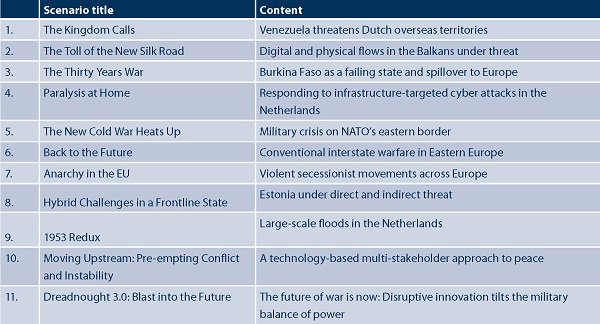
Table 1 Future Conflict Scenarios
The eleven scenarios were also cross-checked against different task and capability lists, including the constitutional tasks of the Dutch Armed Forces, the NATO Essential Operational Capabilities, the strategic challenges from the Dutch Integrated International Security Strategy 2018-2022, the National Risk Profile 2016 as part of the Dutch National Security Strategy and the security themes from the Dutch Defence White Paper 2018. The scenarios were used during two half-day workshops with experts from the Dutch Army. The participants were asked to identify new or to be renewed future capabilities. A capability was simply defined as the ability to attain an objective (ends) using a particular method, approach, or concept of operations (ways) with a set of instruments (means). NATO’s main ability areas – Prepare, Project, Engage, Sustain, C2, Protect and Inform – were used to structure the discussion. This generated a long list of capabilities, which varied in terms of level (strategic-operational-tactical), innovativeness and specificity. We then synthesized and clustered the capabilities in cross-cutting capability development themes using four constituent key strengths of the Netherlands (see Table 2) as well as four alternative lenses on the nature of armed forces (see Table 3) in line with our objective to identify new capabilities.
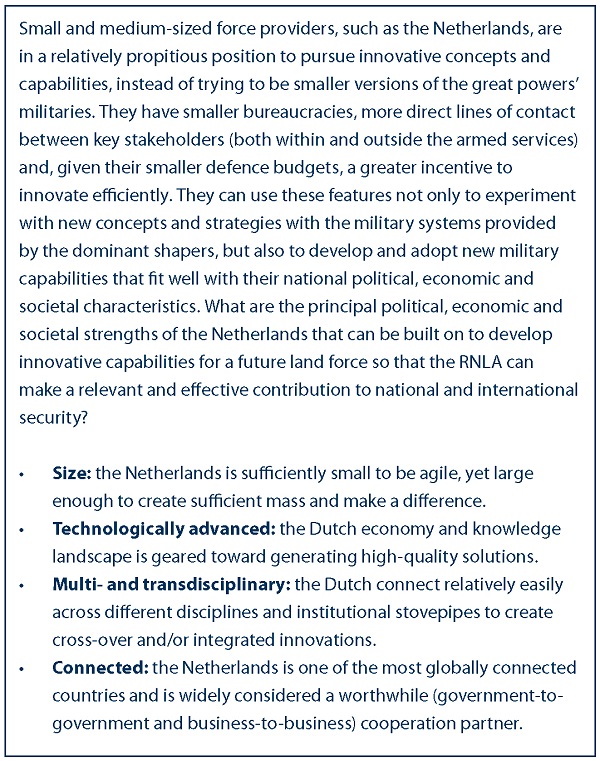
Table 2 Four key strengths of the Netherlands

Table 3 Four alternative lenses
Six Capability Development Themes
Using this process, six dominant (and connected) capability development themes, as depicted in Figure 1, were formulated, each of which is described below followed by one or two examples of lines of capability development for illustrative purposes. Other lines of development are elaborated in the report Playing to Your Strengths.
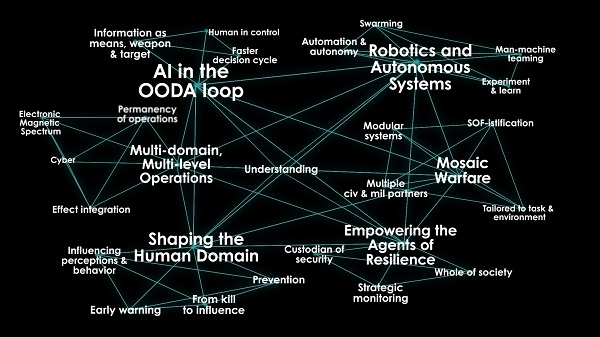
Figure 1 Six Development Themes for the Royal RNLA
Shaping the Human Domain
The term human domain refers to the human in the operational environment, not in a geographical but in a cognitive, sociological, cultural and anthropological sense. The human domain is essentially virtual, but also connected in many ways with the physical world. In most modern-day military missions knowing (situational awareness, SA), comprehending (situational understanding, SU) and being able to influence (shaping) the human domain is crucial. This requires long-term efforts, with time scopes extending beyond that of typical military operations.
Largely driven by this realization, military planners have started putting more emphasis on the phase before an actual conflict starts. Real-life experiences over the past decades in Afghanistan, Iraq and Mali amongst other places, gradually led to the conclusion that these efforts to understand and shape the human domain were not unique to the early pre-intervention stages, but had to be carried out throughout the entire operation (and beyond). As Artificial Intelligence (AI) starts providing us with even more insights into human cognition and behaviour, our ability to influence the human domain is likely to increase exponentially. The ways in which the knowledge and understanding about humans and their environments that lies encoded in texts and various datasets, is being decoded and structured at an accelerating pace. This is happening in academia, but more dramatically in information behemoths, such as Google, Microsoft, IBM, Amazon, Facebook, Baidu, Yandex, et cetera. These companies’ ambitions are not just to structure knowledge about their domain, but to influence human behaviour in ways that are more subtle and more effective than existant ones.
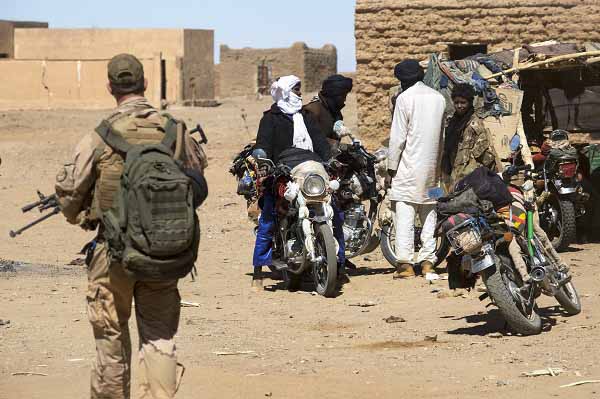
Real-life experiences, for example in Mali, led to the conclusion that the efforts to understand and shape the human domain have to be carried out throughout an entire operation. Photo MCD, Gerben van Es
Land forces including gendarmerie forces are far more anchored in the human domain than air or maritime services.[6] Civil-military capabilities embedded in our land components are starting to build cumulative knowledge about the human domain in ways that may differ from military intelligence communities. It therefore stands to reason that our land components will become the main catalysts of the shift from the kill chain to the influence chain. This would require a significant repurposing and retooling of the physical, cognitive and digital characteristics of the current Army: from brawn to brains.
Design next to Plan. Building on the experience gained with deployed Operational Analysis teams in Afghanistan, military planners should master the art of designing according to the human-centred tradition, next to the ability to plan in the more traditional sense. Knowledge about the behaviour, perceptions, motives, bottom lines, preferred sources of information et cetera of all relevant actors, be it states, key leaders, groups, organizations or corporations, as well as their mutual relationships, is crucial.
Strengthen influence capabilities. The objective of influencing operations is to shape the situational understanding of relevant other actors and thus mould their behaviour. If such operations target military actors, the responsibility (but not necessarily the execution) might lie within the armed forces’ purview. Targeting a wider audience implies a whole of government (and for the execution possibly a whole of society) approach.
Multi-Domain, Multi-Level Operations
Conflicts are increasingly fought simultaneously across physical and virtual domains, in military next to traditionally civilian arenas. Due to the ever deeper integration of information technology, the pace of conflict continues to accelerate while the strategic, operational and tactical levels are further compressed. This means that to be effective, armed forces need to be able to coordinate and synchronize actions both horizontally (across land, sea, air and space, information and human domains) and vertically (across tactical, operational and strategic levels of war). Existing notions of combined arms and joint operations should be taken to the next level.
The morphing of the different domains of war requires much closer coordination and in some cases integration with other services. Command and support relationships will vary over time, with army units being supported at one time and delivering support at the next. For instance, when faced with advanced Anti Access/Area Denial (A2AD) capabilities, the existing division of labour in which the air force weakens the opponent’s military capabilities before the army moves in, may have to be supplemented with new war fighting concepts in which ground forces prepare the way for air forces by puncturing A2AD bubbles. The tactical-strategic level compression and the increasing tempo of operations requires tactical (land) commanders to have a better understanding of the battle space, including the multi-domain threats they face, as well as of the superior commander’s intent at all levels in the chain of command. They also need an immediate grasp of the options, including the toolset, that they have at their disposal to swiftly address these threats. It will necessitate the devolvement of discretionary decision making authority to lower ranking personnel who should be allowed to operate with greater degrees of freedom. The Dutch Army is well-positioned to develop a multi-domain conflict concept and the concomitant capabilities. It first and foremost requires a solution-oriented, multi-disciplinary approach which connects different services and agencies. The development of this approach should focus on the tactical levels of brigade and below.
The ability to integrate effects. Virtually all kinetic and non-kinetic effects brought by the various armed services and other instruments of power converge in the land domain. The Army should act as an effect integrator: monitor and understand the interplay between the various types of effects and their consequences and advise on how instruments deployed by various effectors, military and non-military, should be integrated for an optimal net result.
The ability to coordinate horizontally and vertically with other actors in a security ecosystem, working towards a common goal through the use of shared standards and systems. This includes the ability to direct Joint, Interagency, Multinational and Public (JIMP) activities across different domains, in close cooperation with the other services. It requires robust and reliable communications systems.
AI in the OODA Loop
Over the next decade considerable capability gaps may arise between those actors equipped with advanced AI-powered systems and those without. First and foremost, superior information will enable conflict actors to move more rapidly and thorough through the Observe-Orient-Decide-Act (OODA) cycle. Furthermore, in addition to already being central in the Observe and Orient stages, and thus informing the Decide stage, information will also become the focal point in the Act stage. In the transition to an information society, information inevitably becomes the nexus of clashes of interest. Information is a means, but increasingly also a target and a weapon.

Gathering information during a patrol: Over the next decade, information will become the focal point in the Act stage of the OODA Loop. Photo MCD, Eva Klijn
In the competition for faster and better OODA loops, the loops will increasingly become algorithmic. Big data from a combination of sources will capture reality with increasingly greater levels of accuracy. Data streams will feed directly into complex computerized models which are not constructed by humans but developed through the use of machine learning techniques. The more sophisticated models will not only generate reliable assessments of real-time situations but will also be able to perform courses of action analysis. If real-time decision making is required in order to move faster than the opponent, there might not be enough time for human review of the solutions provided by the system. Automated intelligence assessments will thus spur a drive towards (semi-)automated decision-making.
In analytical roles, AI systems will allow humans to focus on higher-level decisions. The impact is likely to be attenuative rather than transformative. Predictive uses could have more acute impacts, though likely on a longer timeframe. Such applications may change how planners and decision makers understand the potential outcomes of specific courses of action. If, or when, such predictive AI systems become sufficiently accurate and trusted, the spectre of autonomous entities fighting other autonomous entities might become reality. These developments are surrounded with a lot of strategic, ethical, legal and technical issues.
The various OODA loops are more complex in the land domain than elsewhere. There is a lot to observe, be aware of, understand and act upon in the dense, cluttered and diverse land environment. The challenges are therefore multifaceted at the same time as the solution option space is also growing.
Expand information base. Machine learning thrives on copious amounts of data. A prerequisite for experimentation with AI to create more comprehensive SA/SU, is allowing for wider data streams, including metadata from smartphones, drones, satellite images, special operating forces, intelligence services, internet/media analysis, anomaly detection et cetera. The military has a responsibility to foster, facilitate and tap into the interagency and whole of society knowledge networks that are instrumental in creating strategic SA/SU.
Robotic and Autonomous Systems
The emergence of robotic and autonomous systems (RAS) is expected to progressively affect the face of conflict over the next decade. Rapid progress in AI propels an increasing degree of automation of military platforms. Human operators will continue to be involved in the decision to engage targets, but along the different steps in the OODA loop they will increasingly be supported, and at times even be replaced, by machines. The deployment of RAS will significantly improve the range, persistence and mass of land forces and reduce the dependency on the number of human operators that can be fielded. Small, widely dispersed autonomous sensors will contribute to greater situational awareness and support targeting acquisition. Through additive manufacturing (3D/4D printing), some of these auto-sensors can be produced in theatre on demand, on specs, in real time. As long as systems are not fully autonomous (which they are not expected to be for a wide range of tasks for the next decade), this will spur a ‘battle over bandwidth’, since bandwidth is required for human-machine interaction.[7]
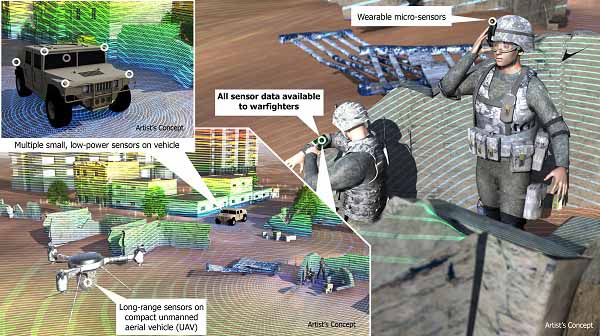
Small, widely dispersed autonomous sensors will contribute to greater situational awareness and support targeting acquisition. Photo US Defense Advanced Research Projects Agency
RAS will change the economics of force acquisition (man-out-of-the-loop relaxes many design constraints), force generation (lower expenditures and more sustainability) and force projection (higher safety for armed personnel). RAS will also pose a significant risk to current generation legacy platforms to become rapidly outdated. It is expected that the emergence of large numbers of disposable and miniaturized unmanned systems will render most traditional military platforms obsolete through direct overmatch (strength in numbers) and cost ratio (the former will be much cheaper). Applications currently already use relatively unsophisticated technology available on the global market.
The battlefield of the near future may not yet be fully robotized, but is likely to be dominated by centaur units that effectively team up humans with machines. Human operators will be assisted by a variety of machines across a range of tasks, including logistical support, reconnaissance and intelligence, – and actual war fighting, with the human operator retaining executive command over the decision to deploy force.
From the perspective of affordability and scalability, RAS are especially relevant to small and medium sized force providers such as the Netherlands. The Dutch Army has recently set up the first small-scale RAS unit which will be allowed to grow organically over the next few years. New configurations for human-machine teaming should be experimented with in training settings, using off-the-shelf technology. Experimentation and learning are the key terms here. Short and rapid prototyping loops should facilitate the speedy translation and implementation in operational concepts and doctrine for land forces. Partnerships with the research and development community should be actively pursued. For now, the Army’s RAS unit should not focus on the development or acquisition of major unmanned land platforms. Instead, it should prioritize creating relationships with developers and producers of the relevant technologies and building knowledge and experience (through Concept Development & Experimentation, CD&E) about how to effectively employ RAS.
Centaur units. Start experimenting with centaur units that leverage the strength of machines to reduce the exposure of Army personnel to enemy fire and create mass while reducing the number of boots on the ground. Concrete areas to initially focus on are:
Small sensor systems which can be flexibly deployed by combat teams in theatre for dedicated real time situational awareness. An example is the use of small airborne autonomous sensor systems to survey and monitor the situation inside buildings.
Autonomous electronic warfare systems that help in gaining dominance in the electromagnetic spectrum. This is essential in an environment where staying connected is a crucial condition for success. Such systems may also provide counter-A2AD capacity, mislead opponents through the saturation of sensors and provide defence against enemy UAVs.
Semi-autonomous land-based and/or airborne logistical support systems, which will enable the Army to conduct land operations with a significantly reduced footprint.
Mosaic Warfare: Distributed and Networked Capabilities
The operational environment features competition and conflict in and across multiple domains, shifting partnerships and multiple conflict challenges. In this context of accelerating innovation, adaptiveness is arguably the defining feature of effective armed forces. Traditional defence development and procurement models which run on longer time cycles and focus on highly specialized systems are no longer fit for purpose to reap the benefits of emerging technologies, which are largely developed in global innovation networks.
An alternative model would be to focus on smaller, dedicated and relatively cheap ‘units of action’ that can intrinsically scale and upgrade quickly and easily. Competitive advantage on the battlefield can be gained through the creation of dynamic ‘mosaics’ of such units which include unmanned systems, small human teams and combinations thereof). Moreover, a mosaic warfare concept will upset the innovation time cycles and adaptability of military capabilities. The engineering burden moves from the tight integration of a unit or a platform and key subsystems to the connectivity and command & control of an entire battle network. The value shifts from the performance characteristics of individual platforms to the resilience of a heterogeneous collective. Critical to this approach is a bottom-up composition ability, which can combine individual elements to create the desired overall effect, often in ways not previously contemplated.

Modularity is central to a mosaic warfare approach and envisages building blocks that are part of a larger toolbox which offers the flexibility to confront a range of challenges. Photo MCD, Gerben van Es
Modularity is central to a mosaic warfare approach. It envisages building blocks that are part of a larger toolbox which offers the flexibility to confront a range of challenges through recombining modules into tailor-made configurations. This applies both to the level of systems (e.g., the Boxer multirole armoured fighting vehicle with its reconfigurable mission modules) and of units (task forces compiled for the mission at hand). In that sense, mosaic warfare is the next – but major – step down a path that has already been treaded. A prerequisite to take this to the next level is the notion of loose coupling, or the minimization of the dependencies between modules, making the (technical and functional) interfaces and modules as simple and as self-contained as possible. This allows for the quick assembly of various operational solutions from different combinations of modules.
Current modular systems and units are mostly tightly coupled, resembling more of a puzzle with specifically shaped pieces fitting together in a unique way, rather than a mosaic with – easily replaceable tiles.[8] Although the mosaic warfare concept is often associated with unmanned systems that act together in swarms, this is certainly not the sole incarnation. Certainly in the land domain, soldiers are indispensable nodes in a distributed network, because they have the all-round cognitive skills to act autonomously in an adaptive way (if so trained and tasked).[9]
Extend reach with (semi-)autonomous capabilities. By equipping soldiers and small teams with (semi-)autonomous operational capabilities, the soldiers’ reach can be extended in order to improve SA/SU, create better protection and possibly decrease lethality. Integrated man-machine teaming arrangements in challenging circumstances require unconditional mutual trust, which takes time to build. The level of autonomy granted to distributed systems – not only for stand-alone tasks, but as an integral part of complex missions – increases over time as confidence builds and the operational experience gained improves the decision making logic of the systems. The focus in this line of development should not be on the technology itself, which can typically be obtained on the market, but on the exploration of new possibilities and limitations (made possible by emerging applied technology); trust building; and on doctrine and tactics development.
Experiment with swarming. Swarms of robotic systems have the potential for even more dramatic, disruptive change to military operations. Swarms bring greater mass, coordination, intelligence and speed to the battlefield. A significantly larger number of much cheaper systems, purpose-built for specific missions, complicates the targeting objectives of adversaries and allows for the graceful degradation of combat power as assets are destroyed. It also allows a family-of-systems approach, increasing diversity and reducing technology risk, which drives down costs. The power of coordinated, intelligent and fast action swarming lies not just in greater numbers. Swarming also enables synchronized mass attack and defence, more efficient allocation of assets over an area, self-healing networks that respond to enemy actions and widely distributed assets that cooperate for sensing, deception and attack. Harnessing the power of swarming will require new command-and-control models for human supervision beyond existing paradigms where humans directly control a vehicle’s movements. Again, many of the underlying technologies are driven by commercial sector innovation. It is therefore high time to start experimenting and innovating together with close knowledge and industrial partners.
Empowering the Agents of Resilience
Most military planning and thinking tends to focus on the acute phase of the contest of wills, in which opponents confront each other across a battlespace. That phase is characterized by enormous difficulties and has led to many painful experiences in military engagements over the past two decades. As a result, political and military leaders are putting more emphasis on prevention and resilience. This section deals with the latter, with the former covered under Shaping the Human Domain. As we have argued, the land component of our armed forces is the most human-centric one. By that token, land forces are in the best position to identify and track the healthy fibres of a society and assess which capabilities could empower those secure healthy fibres against the agents of conflict. In fact, capability investments in the realm of societal resilience may very well prove to be both more affordable and palatable to our post-modern societies compared to more kinetic options. As discussed before, new technology should lead to an unprecedented ability to track and understand the human dynamics that lead to either strengthened or weakened societal resilience.
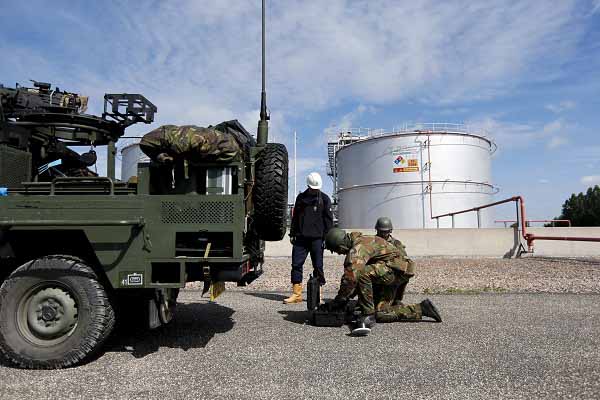
Security is fundamental for economic and societal progress, and armed forces have unique core competencies in enhancing security. Photo MCD, Jasper Verolme
It is clear that prevention and resilience building is predominantly civilian in nature, with the military having a supportive role. But at the same time it is increasingly being realized that security is fundamental for economic and societal progress, and that armed forces have unique core competencies in enhancing security. Furthermore, military organizations are well organized and by that token can generate (some) order and structure for others to operate in and by, even if their role as operators is quite limited. This is not meant in a hierarchical sense of taking command and telling others what to do. Instead, the military should take on a facilitating role. This manifests itself by way of acting as adviser, standard setter, facilitator, supervisor, or de-facto regulatory power in environments where no single actor has the incentive or the mandate to do so. This shift requires adjustment of the traditional military mind set.
Land forces as the custodian of the human domain. In the effort of building societal resilience against security threats, the RNLA could take the role of custodian of the human terrain. This does not only apply to missions in foreign countries but also nationally. Here are some concrete future capability investment options:
- The ability to responsibly track in near-real time drivers of security resilience from the macro (e.g. country) to the micro level (e.g. the individual) through automated and anonymized data exchanges with public and private data collectors.
- The ability to assess which ongoing Dutch non-defence-related (diplomatic, economic, development, investment, et cetera) public and private efforts offer the greatest promise of security resilience enhancements and how the Dutch defence organization might be able to tweak those from a defence and security point of view.
- The ability to identify and monitor key (individual or group) agents of resilience and to increase their centrality in society.
- The ability to engage intelligently and responsibly with social media to explore how they can play a (more) positive role in sustaining and strengthening security resilience.
- The ability to design promising sustainable security solutions in fragile areas where new drivers of resilience are eroding or emerging.
Concluding remarks
Armed forces need to adapt if they want to successfully confront the military challenges of the future conflict environment. Despite all the transformational verbiage of the past quarter-century, future force capability planning is still very much constrained by the capabilities of the current force. Our research project has been an attempt to break free from the shackles of the current force by identifying promising new capability development themes using a mixture of creativity and analytical rigor. These development themes were identified on the basis of a multimethod approach, involving desk research, national and international stakeholder consultation, scenario workshops with the participation of a hand-picked group of forward-leaning, creative thinkers from the RNLA, and the use of key strengths and alternative lenses on armed forces. Instead of sketching a full future force profile, our exercise concentrated on promising new or to be renewed capabilities. Table 4 summarizes the six capability development themes.

Table 4 Six Capability Development Themes
The development of these capabilities will require entrepreneurship and senior level commitment to see them materialized. The themes Multi-domain, Multi-Level Operations and Empowering the Agents of Resilience largely fit within the current notion of the RNLA and point to capabilities that require an intensification and expansion of ongoing efforts rather than to radically new capabilities. AI in the OODA Loop and Robotic and Autonomous Systems build on developments that have already been set in motion but that are still in their very early days. The capabilities in the context of these themes will require significant experimentation with moving targets because the underlying technologies are under rapid development. Finally, the capabilities raised within the Shaping the Human Domain and Mosaic Warfare themes will require considerable expansion of the existing mind set and prevailing practices.
Pursuing the lines of capability development along the six themes will allow the RNLA to continue making important contributions to national and international security for the next decade and beyond. More generally, we submit that deliberations on the future armed force, including those in the context of the upcoming 2020 Memorandum of Reassessment, that predominantly depart from current capabilities, are incomplete. It is time to start taking the potential of new future force capabilities seriously.
* Frank Bekkers is Director of the Security Program at the The Hague Centre for Strategic Studies. Tim Sweijs is Director of Research at the The Hague Centre for Strategic Studies.
[1] Defensienota 2018. Investeren in onze mensen, slagkracht en zichtbaarheid (The Hague, Ministry of Defence, March 26, 2018).
[2] Techflation denotes the tendency of military platforms to become more expensive with every new generation. A more specific measurement of the rate of techflation is captured by Augustine’s law, after Norman R. Augustine, an American Army Undersecretary from 1975-1977, who famously asserted that ‘In the year 2054, the entire [US] defense budget will purchase just one aircraft. This aircraft will have to be shared by the Air Force and Navy 3-1/2 days each per week except for leap year, when it will be made available to the Marines for the extra day.’ For a review and update, see David O. Smallwood, ‘Augustine’s Law Revisited,’ March 2012, p2.
[3] The purpose of the research project was not to come up with a full force profile. In this article – as in our report – we therefore squarely focus on new capabilities without attempting to be comprehensive.
[4] Tim Sweijs, Frank Bekkers and Stephan de Spiegeleire, Playing to Your Strengths. A Different Perspective on Future Capabilities for the Royal Netherlands Army (September 2018) https://hcss.nl/report/playing-your-strengths-different-perspective-future-capabilities-royal-netherlands-army.
[5] Koninklijke Landmacht, Veiligheid is Vooruitzien. De Toekomstvisie van de Koninklijke Landmacht (November 2018) https://www.defensie.nl/downloads/publicaties/2018/11/05/toekomstvisie-koninklijke-landmacht; English version: https://english.defensie.nl/downloads/publications/2018/11/05/vision-of-the-army.
[6] On the contribution of gendarmerie forces in stabilization operations, see P.C.J. Neuteboom, ‘De onderbelichte politiefunctie van de Koninklijke Landmacht tijdens een ‘security gap’. De casus Uruzgan’, in: Militaire Spectator 186 (2017) (11) pp. 496-514.
[7] This may also provide an incentive to some parties to cede more decision power to the machine in highly contested environments. However, bandwidth is an issue regardless of the human control issue because it is required for sensor data transmission.
[8] For example, the interface between the two key modules of the Boxer multirole armoured fighting vehicle, the platform/drive-line and the removable mission module, is very specific (and proprietary). There is still a huge premium on designing the modules that need to be integrated in concert so as to guarantee interoperability.
[9] The effect of technologies on land are often not as great as in other domains due to geography, the interaction with adaptive enemies, the presence of non-combatants and other complexities of the land (and human) domain. The soldier, as the core of a soldier-‘system’, remains central for the army, even if the human-technology balance does
shift more towards the latter.